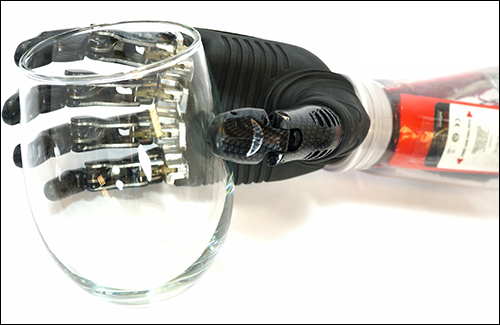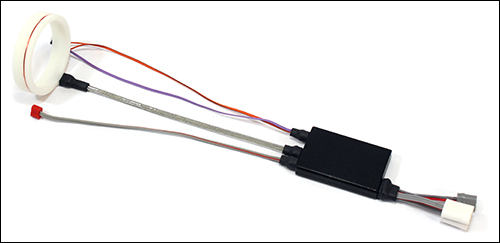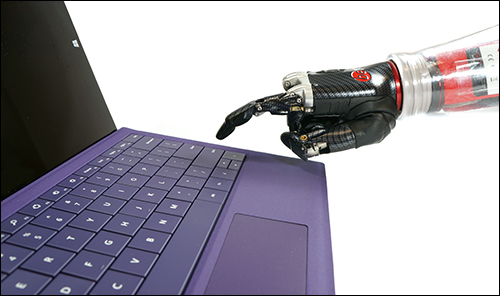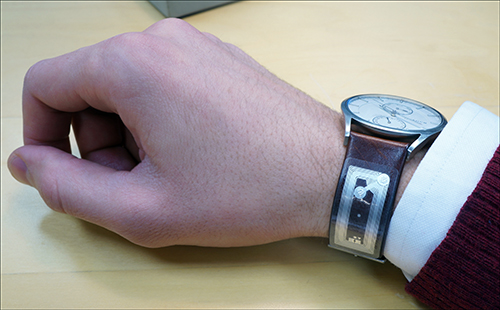Feb 06, 2017Infinite Biomedical Technologies, a Baltimore prosthetic technology company, has released a new version of its morph (Myoelectrically Operated RFID Prosthetic Hand) prosthesis that enables individuals with prosthetic hands to automate their movements with the help of radio frequency identification.
The morph2 brings a new frequency to the technology—high-frequency (HF) rather than low-frequency (LF)—which the company says enables faster transmission, a smaller, lighter design and new functionality. A new, lower-cost alternative to the morph2—known as morph lock—can be locked in place with the tap of an RFID tag against the prosthetic's built-in reader, says Martin Vilarino, Infinite Biomedical Technologies' engineering project manager. "This way," he explains, "the user can grab a delicate object [such as a beverage], lock the prosthesis, and carry on without having to worry about accidentally opening the hand and dropping the object."
Infinite Biomedical Technologies first developed the morph to make prostheses more intuitive for those using the device to pick up objects or perform other tasks (see RFID Helps Amputees Manipulate Prosthetic Hands).
Launched in 2013, the system consisted of a battery-operated RFID reader built into the prosthetic hand's wrist, with tags attached to objects that individuals encountered during their day, such as glasses, jars or keyboards. Morph software, residing on the device, interpreted each tag read, identifying all objects with which a reader was coming into contact, and adjusted the fingers of the hand accordingly, explains Rahul Kaliki, the company's CEO. Since the device was released, the firm has been working with prosthetic users to make the technology more comfortable to wear and more effective to use.
Prostheses can be operated in a few ways. One version, known as electromyography (EMG), uses electrodes to detect and then convert muscle movements to electrical signals that can open and close a hand or vary a grip. However, not everyone can operate the prosthesis properly with the sensor, the company reports—for instance, there may be no suitable location on a person's arm at which electrodes can be fitted to measure muscle movements. In other cases, users must press a button on the prosthesis to switch modes, such as the gripping function—and that is where morph technology provides an added benefit. The system instructs the prosthesis to adjust to the necessary position without requiring directions from the user.
"Morph did well, but it had a couple of limitations," Vilarino says, adding that users asked for something that would be smaller and lighter. The company found that 13.56 MHz HF RFID tags, compliant with the ISO 15693 standard, required fewer antenna coils and could, therefore, enable a smaller reader. It was able to rebuild the device used in prostheses to about half the size, weight and energy consumption by using the HF tag with only two coils—down from 100 for the previous LF version. The weight of morph was 57 grams (2 ounces), while the morph2 weighs just 22.7 grams (0.8 ounce).
The morph2, with a built-in HF chip from AMS, can get through a typical work day without requiring recharging, depending on how heavily it is used. Like its predecessor, it comes with 10 different grips. Because the morph2 employs HF technology it could potentially respond to Near Field Communication (NFC)-based transmissions from a mobile phone, though it is not yet designed to do so.
The company opted against ultrahigh-frequency (UHF) RFID technology, Vilarino says. "They wanted the prosthesis to be predictable," he states, but the long read range of UHF might bring unpredictability due to stray reads.
In addition, the system comes with a locking function to ensure that the hand continues to hold its grip on an object. That function, Kaliki says, was envisioned by a customer who wanted a tag dedicated to locking a hand into its existing position. In that way, users could be sure that they would not inadvertently drop a glass, for instance, since the prosthesis returned to a static grip.
Infinite Biomedical Technologies created an RFID tag that could be attached to a user's watch or sleeve on the hand opposite the one wearing the prosthetic. If the individual was holding a cup of coffee, for example, she would hold her prosthesis wrist within a few centimeters of a tag on the cup, and the hand would create the proper grip to fit it. She would then bring the wrist with the RFID tag (attached to a sleeve or watch) over to the prosthesis and tap it near the built-in reader. The prosthesis would then vibrate twice to confirm that the hand grip was locked.
When the user wished to release the cup, she would tap the wrist tag against the prosthesis again. The reader would capture the tag's ID number and the software would release the grip and prompt the prosthesis to vibrate once, confirming that the hand was no longer locked.
The morph2 development work was funded with a National Institute of Health (NIH) grant awarded in late 2014. The company worked on designing and testing the morph2 with Johns Hopkins University and Advanced Arms Dynamics, then released the morph2 in October 2016.
Prosthetic hands do not sell well in high volume, Infinite Biomedical Technologies reports. But according to the company, several sales to U.S. clinics indicate that the morph2 is of interest to consumers.







